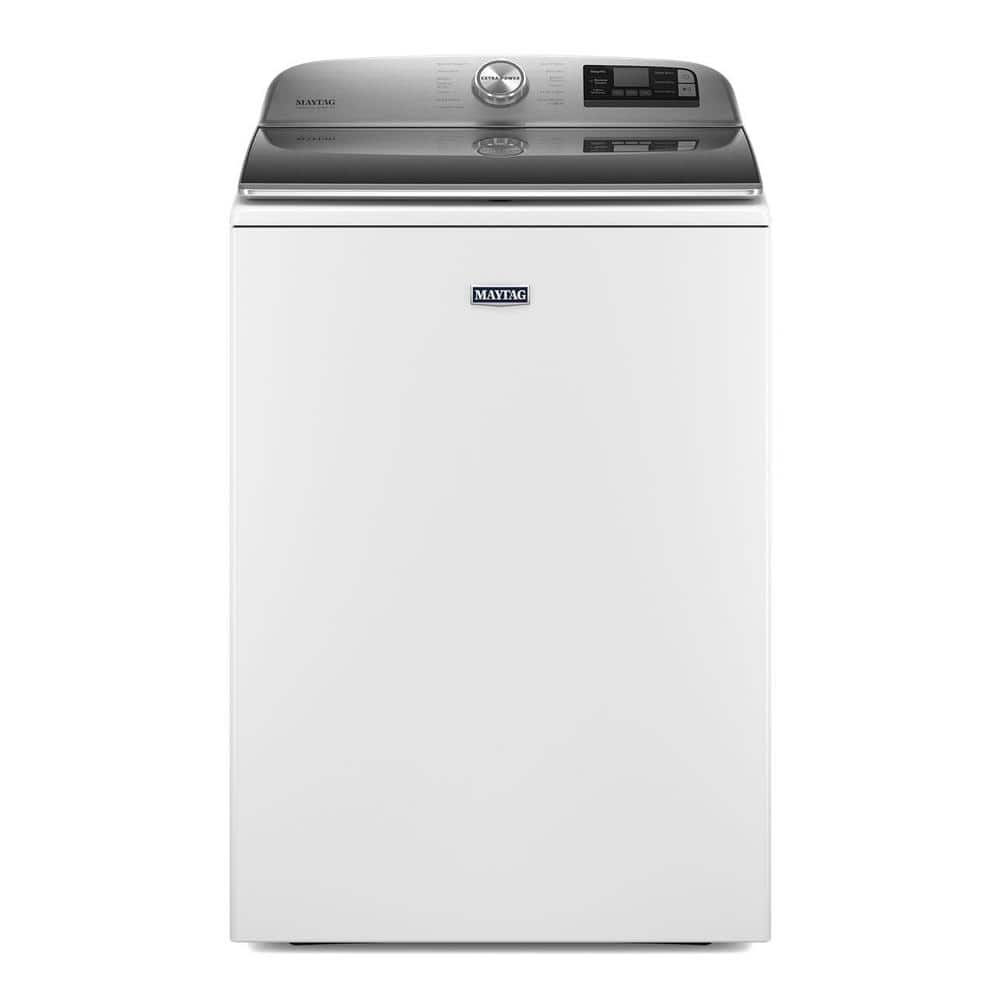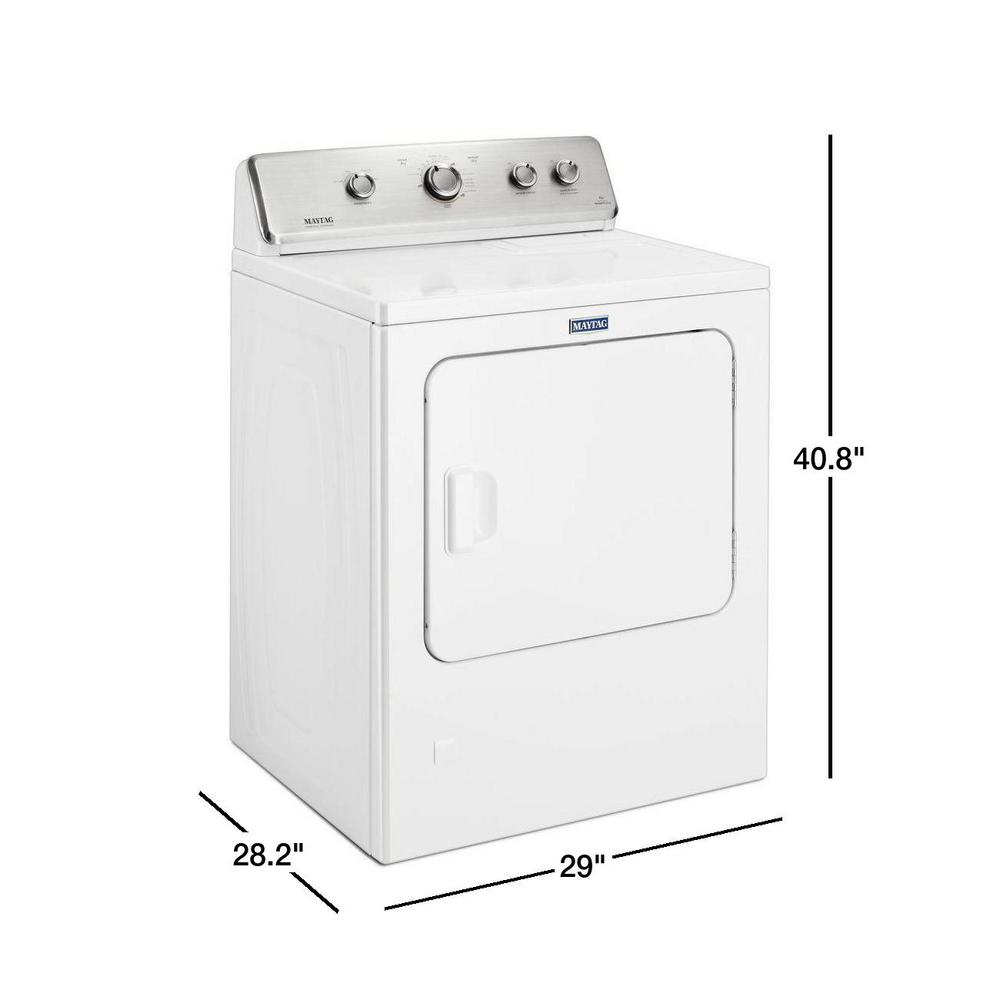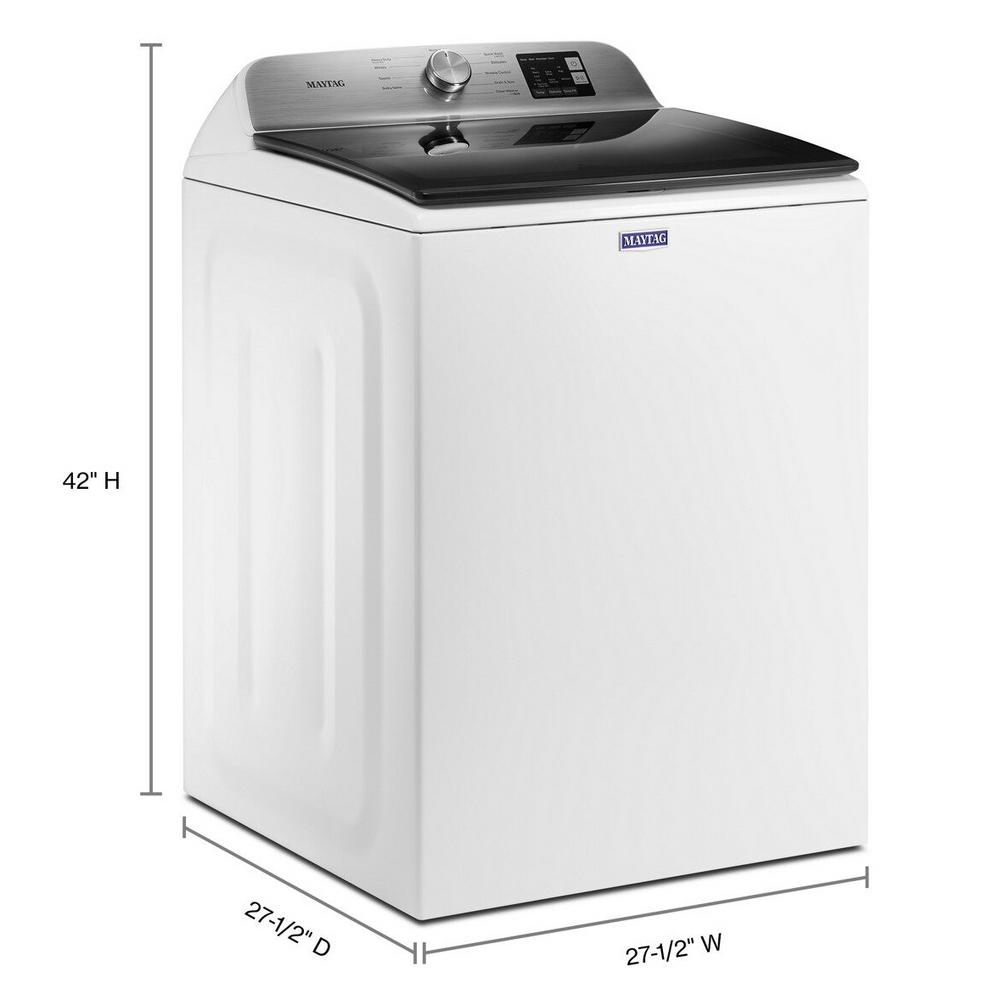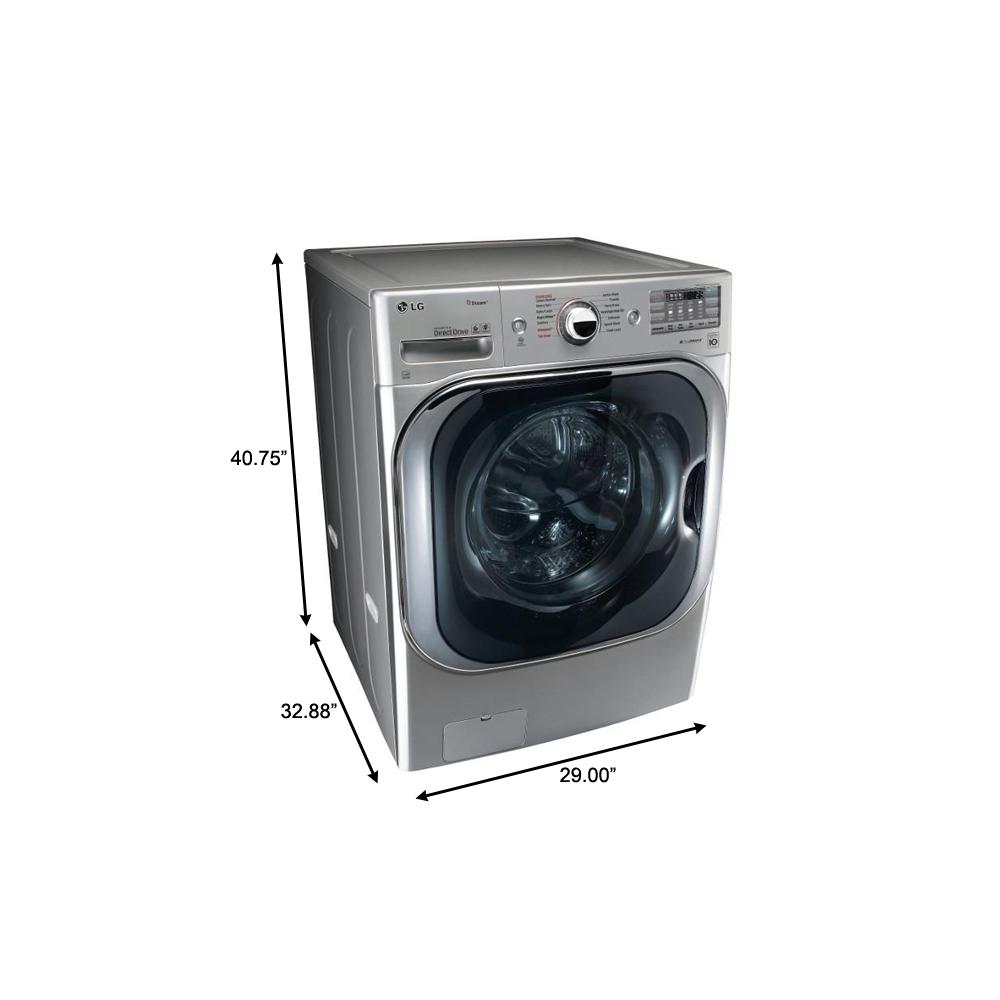Maytag 5.3 cu. ft. Smart Capable White Top Load Washing Machine with Extra Power Button, ENERGY STAR
Heavy Duty cycle with Extra Power delivers powerful cleaning. Pairs best with Electric MED7230HW or Gas MGD7230HW Dryer(s). Manage laundry from anywhere with optional smart features.
Get the heavy duty washing machine that delivers the Most Powerful Cleaning in its class driven by the Heavy Duty cycle with Extra Power button. The Extra Power button boosts stain fighting on any wash cycle, including the Quick Wash cycle. Optional smart washer features like remote start and cycle notifications help you efficiently manage laundry from anywhere.
- Most Powerful Cleaning in its class driven by the Heavy Duty cycle with Extra Power button
- Some stains dissolve best in hot water, others in cold, with the push of a button, Maytag fights both in a single load, the Extra Power button boosts stain-fighting performance on any wash cycle with a dual-temperature wash
- Stay in control and manage laundry from anywhere with optional smart features, use the Maytag app to remotely start or stop your appliance, get end of cycle notifications and troubleshoot select issues
- For more water when you want it, select the Deep Fill option to fill the wash basket with your choice of deeper water levels, the extra water works with robust wash action to effectively break down and rinse away everyday tough messes
- Built-in water faucet is engineered for the extra dirty, use it to rinse away loose soils as clothes go in or fill the tub for up to a 3-hour soak before the cycle begins, delay the start of the wash cycle to take loads straight from soaking to washing without coming back to the washer
- Quick Wash cycle cleans small, lightly soiled loads in 30 minutes with extra high spin speeds, pairing nicely with the Quick Dry cycle on matching Maytag dryers to get your clothes ready in no time
- We don’t just tell you a Maytag washer will get your clothes clean for years: we confidently back our washers with a 10-year limited parts warranty on the direct drive motor and stainless steel wash basket
- Maytag Commercial Technology ensures your appliance is built with commercial-grade parts and works like clockwork year after year, the direct drive motor and stainless steel wash basket are backed by a 10-year limited parts warranty
- Slow-close glass lid offers a clear view of laundry and quiet, precision closing
- ENERGY STAR certified models exceed government standards to help conserve natural resources and save money on your utility bills
- Sanitize with Oxi cycle removes 99.9% of household bacteria, increased wash temperatures and oxygenated additives work together to clean tough messes
- We take pride in building strong, reliable appliances for your home, these washers are proudly assembled by hard-working employees in Clyde, Ohio
- Direct drive motor not only has the power to handle large loads, it’s backed by our 10-year limited parts warranty
- Powerful shock absorbers and springs of Advanced Vibration Control reduce vibration to help keep disruptive noise to a minimum, load after load
- Wrinkle Control cycle is specially designed to help prevent wrinkles with warm water and low spin speeds
- Power impeller attacks everyday tough stains in a single wash with a reverse wash motion and triple action spray that keeps clothes thoroughly saturated with water and concentrated detergent throughout the cycle
- Auto Sensing adjusts the water level for each load to provide efficient cleaning
- Stainless steel wash basket is designed for years of washes and built with sturdy materials to last for the long haul, its also backed by our 10-year limited parts warranty
Additional information
| Capacity - Washer (cu. ft.) | 5.3 |
|---|---|
| Height With Lid Open 90 Degrees (In) | 58.5 |
| Product Depth x Height x Width (in.) | 27.88 x 42.88 x 27.25 |
| Certifications and Listings | Energy Star,UL Listed |
| Manufacturer Warranty | 1 Year Limited |
3 (three) is a number, numeral and digit. It is the natural number following 2 and preceding 4, and is the smallest odd prime number and the only prime preceding a square number. It has religious and cultural significance in many societies.
5 (five) is a number, numeral and digit. It is the natural number, and cardinal number, following 4 and preceding 6, and is a prime number. It has garnered attention throughout history in part because distal extremities in humans typically contain five digits.
Five is the third-smallest prime number, and the second super-prime, since its prime index is prime. Notably, 5 is equal to the sum of the only consecutive primes 2 + 3 and it is the only number that is part of more than one pair of twin primes, (3, 5) and (5, 7), also making it the first balanced prime with equal-sized prime gaps above and below it (of 2). 5 is the first safe prime where for a prime is also prime (2), and the first good prime, since it is the first prime number whose square (25) is greater than the product of any two primes at the same number of positions before and after it in the sequence of primes (i.e., 3 × 7 = 21 and 11 × 2 = 22 are less than 25). 11, the fifth prime number, is the next good prime, that also forms the first pair of sexy primes with 5. More significantly, the fifth Heegner number that forms an imaginary quadratic field with unique factorization is also 11 (and the first repunit prime in decimal, a base in-which five is also the first non-trivial 1-automorphic number).
Five is also the second Fermat prime, and the third Mersenne prime exponent, as well as the fourth or fifth Fibonacci number. It is also an Eisenstein prime (like 11) with no imaginary part and real part of the form . It is the first congruent number, as well as the length of the hypotenuse of the smallest integer-sided right triangle, making part of the smallest Pythagorean triple (3, 4, 5). The regular five-sided pentagon is the first regular polygon that does not tile the plane with copies of itself, and it is the largest face that a regular three-dimensional regular Platonic solid can have, as represented in the regular dodecahedron. In general, a conic curve will require five points in the same way that two points are needed to determine a line.
A button is a fastener that joins two pieces of fabric together by slipping through a loop or by sliding through a buttonhole.
In modern clothing and fashion design, buttons are commonly made of plastic but also may be made of metal, wood, or seashell. Buttons can also be used on containers such as wallets and bags. Buttons may be sewn onto garments and similar items exclusively for purposes of ornamentation. In the applied arts and craft, a button can be an example of folk art, studio craft, or even a miniature work of art. In archaeology, a button can be a significant artifact.
Capable may refer to:
- USS Capable (AM-155), a World War II minesweeper
- USNS Capable, an ocean surveillance ship
- the defining property of a member of a capable group in mathematics
A machine is a physical system that uses power to apply forces and control movement to perform an action. The term is commonly applied to artificial devices, such as those employing engines or motors, but also to natural biological macromolecules, such as molecular machines. Machines can be driven by animals and people, by natural forces such as wind and water, and by chemical, thermal, or electrical power, and include a system of mechanisms that shape the actuator input to achieve a specific application of output forces and movement. They can also include computers and sensors that monitor performance and plan movement, often called mechanical systems.
Renaissance natural philosophers identified six simple machines which were the elementary devices that put a load into motion, and calculated the ratio of output force to input force, known today as mechanical advantage.
Modern machines are complex systems that consist of structural elements, mechanisms and control components and include interfaces for convenient use. Examples include: a wide range of vehicles, such as trains, automobiles, boats and airplanes; appliances in the home and office, including computers, building air handling and water handling systems; as well as farm machinery, machine tools and factory automation systems and robots.
The Maytag Corporation is an American home and commercial appliance company. The company has been owned by Whirlpool Corporation since April 2006.
Top most commonly refers to:
- Top, a basic term of orientation, distinguished from bottom, front, back, and sides
- Spinning top, a ubiquitous traditional toy
- Top (clothing), clothing designed to be worn over the torso
- Mountain top, a mountain peak located at some distance from the nearest point of higher elevation
Top may also refer to:
Washing is a method of cleaning, usually with water and soap or detergent. Regularly washing and then rinsing both body and clothing is an essential part of good hygiene and health.
Often people use soaps and detergents to assist in the emulsification of oils and dirt particles so they can be washed away. The soap can be applied directly, or with the aid of a washcloth.
People wash themselves, or bathe periodically for religious ritual or therapeutic purposes or as a recreational activity.
In Europe, some people use a bidet to wash their external genitalia and the anal region after using the toilet, instead of using toilet paper. The bidet is common in predominantly Catholic countries where water is considered essential for anal cleansing.
More frequent is washing of just the hands, e.g. before and after preparing food and eating, after using the toilet, after handling something dirty, etc. Hand washing is important in reducing the spread of germs. Also common is washing the face, which is done after waking up, or to keep oneself cool during the day. Brushing one's teeth is also essential for hygiene and is a part of washing.
'Washing' can also refer to the washing of clothing or other cloth items, like bedsheets, whether by hand or with a washing machine. It can also refer to washing one's car, by lathering the exterior with car soap, then rinsing it off with a hose, or washing cookware.
Excessive washing may damage the hair, causing dandruff, or cause rough skin/skin lesions.
White is the lightest color and is achromatic (having no hue). It is the color of objects such as snow, chalk, and milk, and is the opposite of black. White objects fully reflect and scatter all the visible wavelengths of light. White on television and computer screens is created by a mixture of red, blue, and green light. The color white can be given with white pigments, especially titanium dioxide.
In ancient Egypt and ancient Rome, priestesses wore white as a symbol of purity, and Romans wore white togas as symbols of citizenship. In the Middle Ages and Renaissance a white unicorn symbolized chastity, and a white lamb sacrifice and purity. It was the royal color of the kings of France, and of the monarchist movement that opposed the Bolsheviks during the Russian Civil War (1917–1922). Greek temples and Roman temples were faced with white marble, and beginning in the 18th century, with the advent of neoclassical architecture, white became the most common color of new churches, capitols, and other government buildings, especially in the United States. It was also widely used in 20th century modern architecture as a symbol of modernity and simplicity.
According to surveys in Europe and the United States, white is the color most often associated with perfection, the good, honesty, cleanliness, the beginning, the new, neutrality, and exactitude. White is an important color for almost all world religions. The pope, the head of the Roman Catholic Church, has worn white since 1566, as a symbol of purity and sacrifice. In Islam, and in the Shinto religion of Japan, it is worn by pilgrims. In Western cultures and in Japan, white is the most common color for wedding dresses, symbolizing purity and virginity. In many Asian cultures, white is also the color of mourning.
With or WITH may refer to:
- With, a preposition in English
- Carl Johannes With (1877–1923), Danish doctor and arachnologist
- With (character), a character in D. N. Angel
- With (novel), a novel by Donald Harrington
- With (album), a 2014 album by TVXQ
- With (EP), a 2021 EP by Nam Woo-hyun






Reviews
There are no reviews yet.